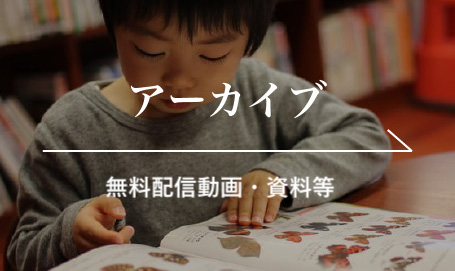< VOLUME 49, No.1 >
Tazawa Kaoru. Unification of the Kindergarten and the Daycare Center an Historical Analysis of Japanese Nursery Education.
Research on Early Childhood Care and Education in Japan, 2011, 49(1), 18-28.
The Japanese government is now planning to unify the kindergartens and the daycare centers, established in the 19 century by the Ministry of Education and the Ministry of Interior, respectively. Actually, this is not the first time this unification has been undertaken; since World War 1 the government has made 5 failed attempts. The present report investigated these attempts which all ended in failure due to the jurisdictional disputes between the two ministries. Considering the historical backgrounds, the current unifying plan might draw strong resistance again from the respective sides of the kindergartens and the daycare centers. However, united nursery education does not mean the mere unification of the two traditional systems. It is necessary to review the current Japanese nursery education from the standpoint of the children, and to develop a novel plat-form of united nursery education in order to solve its problems.
Keywords: unification of kindergarten and daycare center, daycare center, kindergarten, child welfare, Kurahashi Sozo
—————–
Fujita Sumito. Meaning of body contact that is found in infants’ play : From the viewpoint of embodied knowing.
Research on Early Childhood Care and Education in Japan, 2011, 49(1), 29-39.
Regarding the meaning of the body contacts which infants perform in play, a longitudinal observation on body contacts was carried out with 3, 4, and 5 years-old children. Based on the classification by Tsukasaki and Muto (2004), the differences among ages were statistically specified and compared. It emerged that particularly 5 years-old children employ “neutral” body contacts, such as “inducement” and “appeal”. Based on the results, the body contacts were classified into four types and were then considered by observing and analyzing the context before and after the body contacts of the 5 years-old children arise. In conclusion, it can be said that 5 years-old children use body contacts implicitly, but skillfully as a tool and a means. This suggests that this body contact is that the classified as embodied knowing.
Keywords: infant, body contact, embodied knowing
—————–
Sato Chie. Analysis of “Childcaring-ness” through Auto-Ethnography : “Untold” childcare as the framework.
Research on Early Childhood Care and Education in Japan, 2011, 49(1), 40-50.
The purpose of this study is to clarify the aspect of “childcaring-ness” which is part of the child-caring person. As the study method, three types of records about the person’s own practice of child care were used in an auto-ethnographical method with “untold” child care as the framework. The “childcaring-ness” in this study is defined as what is represented by the picture of ways of receiving and thinking drawn in the auto-ethnography, distinctive of the child-caring person. The results of the analysis highlighted three matters considered to depict “childcaring-ness”: 1) hesitation about specialization, 2) unconscious awareness and 3) giving meaning to one’s own child care. By shedding light on “untold” child care by auto-ethnography, the portrayal of the “childcaring-ness” which exists in the invisible practice of child care was made possible.
Keywords: “untold child”, “auto-ethnography”, “child caring-ness”
—————–
Ogawa Aki. The support for highly-educated and older-aged first-time mother whose child is in Nursery School : Creating a relationship between the mother and a teacher in Nursery School.
Research on Early Childhood Care and Education in Japan, 2011, 49(1), 51-62.
When well-educated women of older ages have children they are forced to change their lifestyle most especially concerning employment. The support for them is difficult and this population of women is increasing causing this to become an urgent issue. This article suggests a model plan. The research uses a case-based method and focuses on the change during the support received by the author between the childcare worker and the women, their children and childcare worker, and the women and the childcare worker. The author points out how to build those relations and what support causes it and finds that childcare workers should show them the process of their child growing up without problems. Childcare workers need to have close relations. When the well-educated women have multiples, building relationships is even more difficult. So the childcare workers should plainly show the process.
Keywords: Child-care practice, Mother and child support, relationship building, attachment forming support, highly educated mother who has first child in older age
—————–
Nishikouji Katsuko. A Dawn of the Child Centered Practice of Early Childhood Care and Education : The Study of Records of Aishu Kindergarten’s Care and Education (From Meiji 28 to 40).
Research on Early Childhood Care and Education in Japan, 2011, 49(1), 6-17.
This study intends to approach the kindergarteners’ viewpoints of childhood and practice during the Meiji period by analyzing the diaries and records of early childhood education, which were left in Aishu Kindergar-ten, Osaka. The author can verify the changes of content and methods of early childcare and education, for instance, the transition of gift from orthodoxy to child-centered, and the thinking of optional trial and play. Furthermore, the author grasps the realities and mentalities of kindergartners in several ways: with sincerely making great efforts on the trial and error for making the format of the records of care and education, the examination of the weekly and daily programs, eagerness to develop materials for instruction and the affection for the work of the children.
Keywords: Aishu Kindergarten, Meiji period, Kindergartener, the diaries and records of early childhood education, contents and methods of early childhood care and education
—————–
Fukui Itsuko. The Necessity of Day-care for Sick Children at Day Nurseries : Investigation Through Interviews at Day Nurseries in Ishikawa Prefecture.
Research on Early Childhood Care and Education in Japan, 2011, 49(1), 63-72.
This investigation was carried out by using interviews focused on the current problems and situation regarding day care for sick children at sixty day nurseries in Ishikawa Prefecture. The findings show that differential districts exist in the practice of day care for sick children in the prefecture. However, even in rural areas, a greater need has arisen for day nurseries due to the work commitment of grandparents as well as a lack of a strong sense of community. Regarding the future of this issue, maintenance of the medical room, distribution of the nurses, and collaboration with part-time medical doctors are a few of the goals that need to be considered. This study on how to care for sick children in nurseries should be conducted further while keeping the “child-centered” view in mind.
Keywords: day nursery school, day care for sick children, medical room, nurse, part-time medical doctor
—————–
Porter Noriko. Developing Circumscribed Interests of Children with High-Functioning Autism Through the Project Approach : An Exploratory Study.
Research on Early Childhood Care and Education in Japan, 2011, 49(1), 73-84.
The purpose of this longitudinal case study is to examine the effectiveness of Project Approach as a guiding strategy to develop and expand circumscribed interests in young children with autism spectrum disorders (ASD). The subject was the author’s son who is a child with high-functioning autism. He had an excessive interest in trains throughout his early childhood years. As an early childhood educator, the author began introducing a project based on the topic of trains in the home setting when the subject was three and a half. The results showed the effectiveness of intervention, using the Project Approach as a guiding strategy. The three implementations included: (1) creating a web that provides a strategic plan for expanding circumscribed interests in various directions, (2) providing an opportunity to play with an experienced player, and (3) encouraging documentation through various media, to cultivate play skills for children with autism.
Keywords: Autism, Circumscribed Interests, Project Approach, Webs, Documentation
—————–
Manabe Ken. A Study about Transition Support for Children with Special needs and their family : Development and a trial of The Transition Support Model that contains vertical and horizontal transition.
Research on Early Childhood Care and Education in Japan, 2011, 49(1), 85-95.
The purpose of this study is to consider the transition support for children with special needs and their family through a case study and development of The Transition Support Model. The Transition Support Model was developed for application to a child who was going to enter a daycare center and on the premise that there are 2 types of transitions: vertical and horizontal. The model was composed with 3 levels; the level of purpose, the level of activity, and the level of cooperation and relationship. The purpose of Support was determined as to support the adaptation of children to a new environment. Through this case, it became clear that a relationship between people and institutions should be considered to carry out feasible activities.
Keywords: Transition, children with special needs and their family, Transition Support Model
—————–









